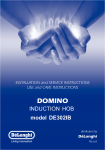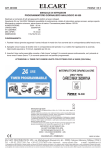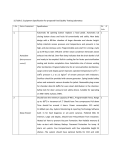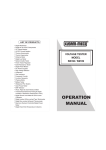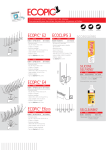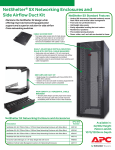Download INSTALLATION & OPERATING INSTRUCTIONS
Transcript
Cool like the breeze ... naturally. INSTALLATION & OPERATING INSTRUCTIONS Please read carefully before commencing the installation Con EMC forms w of S require ith tand m en 104 4:19 ard AS ts / 9 N 5M ZS 1st an Jan uary datory 199 9 Cool like the breeze ... naturally. Pty. Ltd. ABN 62 003 649 509 37 Robinson Road Virginia QLD 4014 Telephone: (07) 3633 0395 Facsimile: (07) 3633 0481 Freecall: 1800 637 175 Email: [email protected] Introduction to Breeze Power Congratulations on choosing a Breeze Power Natural Cooling System, the environmentally friendly and money saving alternative to air conditioning. The Breeze Power System is made up of the following components:• • • • A quiet, belt driven six bladed fan available in five sizes Ceiling shutter to suit Motor and control switch Roof space exhaust vents The generic name for a Breeze Power system is a “Whole House Fan”. Whole House Fans have been keeping people cool and comfortable since the 1940s. SIZING THE SYSTEM TO SUIT THE HOME The Breeze Power brochure lists the maximum output in cubic metres per hour (M3/H) for each Whole House Fan. Calculate the cubic area of the house (length x width x ceiling height). In a split level or two storey home, measure each level. In temperate climates an air change rate of 30 to 35 per hour through the home is the norm. In hotter areas, 40 to 45 air changes will give optimum results. Example: Temperate Climate Ground Floor Area L12M x W 10M x H 2.4M = 288 M3 First Floor Area L 8M x W 7M x H 2.4M = 134 M3 Total Cubic Area 422 M3 Output required to provide 40 air changes per hour is 422 x 40 = 16,880 M3/H Therefore the 915mm Breeze Power Fan with a maximum airflow rate of 17,500M3/H is suitable. CHOOSING THE BEST LOCATION In a single storey home, the fan is best located over a common area such as a hallway. In double storey or split level homes the fan is best located over the landing area where doors lead off near the top of the staircase. In some instances the shutter for the ideal size fan will not fit in the hallway. It therefore may need to be installed in a high traffic area of the house such as over the kitchen/family room area rather than a less active and more isolated room such as a formal lounge room or bedroom. If this is not acceptable a smaller, slightly less effective system may have to be selected. 2 LOCATION REQUIREMENTS FOR A BREEZE POWER SYSTEM ROOF SPACE WITH RAFTERS Check that there is an absolute minimum of 800mm of height (600mm and 760mm fan) 900mm (915, 1070mm Fan), 1000mm (1220 Fan) from the ceiling joists to the rafters. This is to ensure the fan can be passed up into the roof through the ceiling opening cut for the shutter. It also guards against back pressure where the air hits the roofing material and blows back into the room before it can disperse around the roof space. This reduces the efficiency of the system and causes the ceiling shutter to flutter. Measure the ceiling area where the shutter will be located and check that the ceiling shutter will fit. Preferred locations are “walk through” areas of the home such as hallways, landings or where open areas flow from one to another. If the cornices are slightly too wide you can cut the cornice to make the shutter fit. Alternatively the shutter may be “dropped” down to fit over the cornice with beading inserted behind the shutter to seal the gap between the shutter flange and the ceiling surface. GANG NAIL TRUSSES Check that there is an absolute minimum of 800mm of height (600mm and 760mm fan) 900mm (915, 1070mm Fan), 1000mm (1220mm Fan) from the ceiling joists to the rafters. This is to ensure the fan can be passed up into the roof through the ceiling opening cut for the shutter. It also guards against back pressure where the air hits the roofing material and blows back into the room before it can disperse around the roof space. This reduces the efficiency of the system and causes the ceiling shutter to flutter. Breeze Power gang nail truss shutters have a fixed central blade running lengthwise to cover the bottom cord of a truss with the pivoting blades on either side. The longest dimension of the shutter is therefore always parallel with the direction of the truss. This must be taken into account when selecting the spot for installation of the system. For example, if the trusses are running across a narrow hallway, the shutter will not fit and another location will have to be found. The Fan plenum sits over the bottom cord of the truss. Check that the fan will fit between the webs. The fan may be tilted slightly to make it fit and the high side boxed down to the mounting platform. The Breeze Power fan can be pushed up into the roof space through the space on either side of the cord if the metal fan frame is temporarily removed from its wooden plenum and the two pushed through separately. If the home is under construction it may be possible to adjust truss spacings so a standard ceiling shutter can be used. 3 INSTALLATION INTO A STANDARD RAFTER ROOF OVERVIEW OF INSTALLATION STAGES: • Measure and cut out ceiling opening for the shutter. Build fan platform and install fan. • Install exhaust vents in roof space (under-eave or gable end). • Wire up motor and switch. Install ceiling shutter. • Test system and ceiling shutter operation – Install optional safety cover over fan. (Gang Nail truss roofs see page 6) (1) After the installation site has been selected, remove the shutter from its carton and check measure its actual internal dimensions (These are the dimensions for the ceiling opening). The internal dimensions are generally 50mm smaller than the overall flange to flange measurements. (2a) Using a ruler and pencil, mark these measurements on the area of ceiling selected. Drill a small hole at each corner of the outline you have marked on the ceiling. (2b) Return to the roof space and inspect the area again before cutting the ceiling or sawing the joist. Check for electrical wiring, water pipes etc. (3a) Inside the roof space cut the ceiling joists 45mm from the shutter opening. This is to accommodate additional framing to support the joists once they have been cut. (3b) Frame the ceiling opening using joist-sized timber equal to existing joists to a minimum height of 100mm above the ceiling material. (Note: Packing may be required if the ceiling joists are only 75mm high). 4 (4) Using 100mm x 25mm timber for 600mm, 760mm and 915mm dia fans or 200mm x 25mm timber for 1070mm or 1220mm fans build a platform to support the fan. Hint: If there is plenty of height above the fan, build the platform higher for an even quieter installation. The outside dimensions of your platform should be a minimum of 50mm greater than the outside dimensions of the timber plenum of the fan (check) measure the frame of your fan). Hint: Paint the platform and plenum timbers black so that light from the room will not show up the cut timbers when the shutter is open. (5) Push the fan into the roof space via the framed ceiling opening. Centre the fan’s timber frame on to the platform and ensure it is level. Toe nail to the platform using 50mm nails. Remove the single screw on either side of the metal fan frame which holds it on to its timber plenum. The fan will now “float” on its rubber packing to ensure no vibration. Check that the fan frame is itself level on its own plenum. (6) Fasten the motor to the mounting flap using the bolts provided. Ensure the pulley on the motor and the larger pulley on the fan hub are both level and tightly secured. Place the belt around the two pulleys. Attach the automatic tensioning spring to the motor mount and fan frame. This will ensure the belt always remains at the correct tension. (7) Install roof space exhaust vents. The system is now ready for wiring. 5 GANG NAIL TRUSS ROOFS USING “NO CUT JOIST” CEILING SHUTTER OVERVIEW OF INSTALLATION STAGES: • Measure and cut out ceiling opening for the shutter. Build fan platform and install fan. • Install exhaust vents on roof space (under-eave or gable end). • Wire up motor and switch. Install ceiling shutter. • Test system and ceiling shutter operation – Install safety cover over fan. (1a)After the installation site has been selected. Get into the roof space and pierce the gyprock either side of the truss with a small, sharp screwdriver. (1b)Go into the house, measure and mark the ceiling opening dimensions of your size shutter. Drill small holes at each corner of the area marked on the ceiling and double check the shutter position from the roof space before cutting the ceiling opening (1b). (2) Cut shutter opening on either side of the cord. (3) This is the point at which the fan must be pushed up into the roof space. Remove the two screws holding the metal fan frame to its wooden plenum. Lift the metal fan frame off its timber plenum and tilt it vertically to push it up through one of the shutter openings either side of the cord. Then push up the timber plenum. 6 (4a) Return to the roof space. Frame in the opening using joist size timber equal to the existing cord to suit the ceiling opening. Using 100mm x 25mm timber for 600mm, 760mm and 915mm diameter fans or 200mm x 25mm timber to 1070mm or 1220mm fans build a platform to support the fan. (4b) The outside dimensions of your platform should be a minimum of 50mm greater than the outside dimensions of the timber plenum of the fan (check measure the plenum of your fan). Hint: Paint the platform and plenum timbers black so that light from the room will not show up the cut timbers when the shutter is open. (5) Centre the timber plenum which you removed from the fan frame on the platform and ensure it is level. Toe nail to the platform using 50mm nails. Place the fan metal frame on its plenum but do not replace the two screws you removed to push it into the roof space. The fan will now “float” on its rubber packing. Check that the metal fan frame is itself level on its own plenum. (6) Fasten the motor to the mounting flap using the bolts provided. Ensure the pulley on the motor and the larger pulley on the fan hub are both level and tightly secured. Place the belt around the two pulleys. Attach the automatic tensioning spring to the motor mount and fan frame. This will ensure the belt always remains at the correct tension. (7) Install roof space exhaust vents. The system is now ready for wiring. 7 MINIMUM VENT AREAS FOR THE ROOF SPACE FAN SIZE MINIMUM VENT AREA M2 sq.Ft. UNDER EAVE VENT 1200 x 250mm 600mm 24” 0.6M 6 Sq.Ft. 2 760mm 30” 0.92m 10 Sq.Ft. 3 915mm 36” 1.10m 12 Sq.Ft. 4 1070mm 42” 1.50M 16 Sq.Ft. 5 1220mm 48” 1.90M 20 Sq.Ft. 6 The standard Breeze Power under eave vent is made from maintenance free powder-coated steel and is 1200mm long by 250mm wide. Ensure you have the correct number of eave vents for your particular Breeze Power Fan. Because the Natural Cooling System rapidly expels air from the roof space by air pressure not convection eave vents are preferred. Eave vents offer more protection against strong wind pressure entering the roof space compared with gable vents. Avoid fine insect mesh on eave vents in case of clogging with dust from the roof space which could reduce air flow and cause problems. If your natural Cooling System is installed in a central location, position the eave vents evenly around the home. If the system is installed towards one end of the roof space then install more eave vents towards the other end of the roof to ensure good air flow through the roof space. GABLE END VENTS If using gable end vents take into account that only 60% of the area of a gable end vent represents free air, the rest is structure. Ensure your gable end vent(s) have deep, weatherproof louvres and come with birdwire on the back. WIND TURBINES Most wind turbines move too little air to be really useful. As a rule of thumb, one wind turbine with a 300mm diameter neck equals half an Eave Vent. A standard Breeze Power Under Eave Vent offers 0.3 square metres or 3.2 Sq.Ft of free air. 8 PRODUCT ADVICE SHEET MODEL MSC1200S-L-WP Solid State Fan Speed Controller FEATURES • • • • • • Provides stepless electronic speed control for all the Breeze Power Natural Cooling single phase PSC induction blower motors. Speed may be varied using a front mounted rotary control knob between OFF, the maximum speed and a pre-set minimum speed. Integral switch as part of the rotary speed control knob. Integral LED ON indicator that does not require separate neutral. Mounted on an HPM wall plate for flush wall or surface mounting. Reverse power knob ensures positive shutter opening at switch on. Cool like the breeze ... naturally. SPECIFICATIONS RATING 240 volt, 5 amp, 50/60 Hz, 1200 VA up to 32°C in free air. De-rate at 20 VA per °C above 32°C. Max controller case temp 70°C. PLEASE NOTE: For the Breeze Power application the controller is rated at max 4 A 1000 VA up to 42°C and is suitable for all Breeze Power fans. SPEED SETTING The rotary knob varies the motor speed between OFF (fully anti-clockwise) to full speed (~210°) and then the minimum speed (170°) in a clockwise rotation. Motor always starts / stops at the highest speed setting automatically. Pre-set minimum speed adjustable via preset adjuster. ENCLOSURE Mounted on a screen printed HPM 770/1PLWE switch plate with an integral switch as part of the rotary speed control potentiometer. Size mm: Module 53Wx37Hx50D. Mounted on wall plate 115x70x70 Wt 220gm CONNECTIONS Three 65mm leads, 24/020 250 volt V105 PVC Brown = active Red = motor main White = motor aux & ancillaries SHAFT / KNOB 6mm plastic shaft with brushed aluminium indicating knob. ELECTROMAGNETIC COMPLIANCE This controller is fitted with an Electromagnetic Interference suppression network, and complies with the requirements of AS/NZS CISPR 14.1:2003 when correctly installed. See over page for the installation requirements. ACA C Tick no. N13956. OPTIONS Breeze Power fans can be fitted with a number of controller options. Please enquire. * Multiple fans on a single controller * Surface mounting wall box * Timer controller 1-8 hr. RELIABILITY Breeze Power controllers are built for long service life and are proudly designed & manufactured by Powerform Controls in Australia using high grade components. Appropriate quality control is ensured throughout their manufacture with a commitment to on-going research and development of the product line. 9 CIRCUIT AND CONNECTION DIAGRAM FOR 234W MOTOR AND MSC 1200B-WP SPEED CONTROLLER 600MM, 760MM, 915MM AND 1070MM BREEZE POWER FANS READ THESE INSTRUCTIONS BEFORE COMMENCING ANY WIRING. The electrical connection of your Breeze Power Fan can only be carried out by a licensed electrical contractor and must conform to State Codes. The motor supplied requires a 240V 50Hz, single phase AC 2.2 AMP supply. The MSC 1200-L-WP Fan Speed Controller complies with the EMC requirements of Standard AS.NZS 1044:1995 mandatory from 1st January 1999, when installed in the manner specified. To comply with the EMC requirements, shielded cable (supplied) MUST BE USED for the conductor connecting the controller to the main winding (blue cable) of the motor, as marked on the diagram below. One end of the braided wire shielding must be connected to an earth of the supply, the other end of the shielding should remain unconnected. As the motor frame must be connected to earth, the cable shielding may be conveniently earthed in the junction box where an earth terminal is provided. Earthing should be in accordance with AS3000. If the controller casing is accessible to personal contact, then it must be earthed. If the controller casing is not accessible to personal contact, then it need not be earthed. NOTE: The cross sectional area of the braiding of the shielded cable provided is too small to be a suitable earth conductor. The junction box should be mounted in the roof space near the fan motor. It should be located on the side of an adjacent roof timber. WIRING DIAGRAM FOR BREEZEPOWER VARIABLE SPEED FAN 10 CIRCUIT AND CONNECTION DIAGRAM FOR 315W THREE SPEED MOTOR 1220MM BREEZE POWER FAN WARNING THIS MOTOR IS DESIGNED TO BE CONTROLLED ONLY WITH THE THREE FIXED SPEED WALL MOUNTED CONTROL SWITCH PROVIDED. DO NOT CONNECT THIS MOTOR TO ANY SOLD STATE SPEED CONTROL DEVICE. TO DO SO RISKS FIRE OR ELECTRICAL SHOCK. This motor supplied requires a 240V 50Hz, single phase AC 2.5 AMP supply. The junction box supplied should be mounted in the roof space near the fan motor. It is usually located on the side of an adjacent roof timber. Installation should be carried out by a licensed electrical contractor and should conform to State Codes. WIRING DIAGRAM FOR BREEZEPOWER THREE SPEED FAN 11 PRODUCT ADVICE SHEET MODEL LDT8B-MSC1200 Delay-Off Timer FEATURES • • • • • • • • • Cool like the breeze ... naturally. • Automatically invoked delay-off period that is user adjustable from 1-8 hours. Separate integral adjustable fan speed controller. 12 second full speed fan boost upon power up. Mounted on a 114x114mm double wall plate. Cut out required 93x78mm. Can be flush mounted in gib or hollow core walls or surface mounted in a special surface mounting enclosure. Surge protected. Maximum load of 5 A 1200 VA Integral ON/OFF switch LED indicator which shows timing period as well as standby/timing complete. Single or multiple fans. OPERATING INSTRUCTIONS Turn “Time ON hours” knob from OFF to required delay period. Fan will come on at full speed for ~12 secs. After 12 secs you are able to adjust “Fan Speed” to any desired level. Green / orange LED indicates timer in operation and fan is on. Red LED indicates time period expired and fan off - unit still ON in standby. After time period has elapsed (red LED), it is recommended that the right hand knob is switched off. If the power fails, unit will reset automatically upon resumption of power. Fan Speed knob may be left in any desired position and does not need to be adjusted each time the fan is switched on. To reset for a further period, switch off then on again. SPECIFICATIONS RATINGS 240 volt, 5 A, 50 Hz, 1200 VA inductive or resistive load (cos Ø 0.4 – 1.0) OPERATION and TYPICAL APPLICATION Single period automatic switch-off timer for fans or general inductive or resistive loads that are required to run for a user selectable preset period. Fan speed or load power is adjustable after 12 sec power up. TIME INTERVAL and ACCURACY Delay-off timer 1-8 hours. Power-up timer 12 seconds. Other times available by special request. Accuracy and reproducibility +/- 10%. CONNECTIONS 4 way terminal block with cage type screw connectors. Separate earth bolt provided on motor speed. ENCLOSURE Mounted on HPM double wall plate for fitting into 93 x 78 mm cutout in wall. Depth behind wall plate is 46mm. Gib mounting plates provided as standard accessories. FAN SPEED CONTROL Powerform MSC1200B solid state continuously variable fan speed controller mounted on timer board. This controller is fitted with an Electromagnetic Interference suppression network, and complies with the requirements of AS/NZS1044:1955 & AS/NZS CISPR 14.1:2003 when correctly installed. RELIABILITY Breeze Power controllers are built for long service life and are proudly designed & manufactured in Australia for Breeze Power by Powerform Controls using high grade components. Appropriate quality control is ensured throughout their manufacture with a commitment to on-going R & D of the products. 12 CIRCUIT AND CONNECTION DIAGRAM FOR 234W MOTOR AND 8 HOUR TIMER For use on 600mm, 760mm, 915mm and 1070mm only. The optional Breeze Power Timer provides the option of selecting a time period for the fan to run 1 hour - 8 hours. Indicator lights show whether the timer is in operation. The timer is coupled with an infinity controllable switch to adjust the fan speed to the desired level. WIRING DIAGRAM FOR BREEZEPOWER VARIABLE SPEED FAN WITH TIMER NB. The timer can only be used on the 600mm, 760mm, 915mm and 1070mm fans. IT CANNOT BE USED ON THE 1220mm FAN. Cool like the breeze ... naturally. 13 MOTORISED SHUTTER INSTALLATION INSTRUCTIONS For applications that require a motorized shutter – Vertical installations, Fans mounted in canopy or installations where fire safety requirements are specified. WIRING DIAGRAM FOR BREEZEPOWER VARIABLE SPEED FAN WITH OPTIONAL SHUTTER MOTOR 600mm FAN 760mm FAN 915mm FAN 1070mm FAN 1220mm FAN EXTERNAL 660mm X 660mm 810mm X 810mm 965mm X 965mm 1118mm X 1118mm 1270mm X 1270mm INTERNAL 600mm X 600mm 760mm X 760mm 915mm X 915mm 1070mm X 1070mm 1220mm X 1220mm MAY BE MOUNTED VERTICALLY OR HORIZONTALLY 14 WIRING DIAGRAM FOR THREE SPEED BREEZEPOWER FAN WITH MOTORISED SHUTTER 15 INSTALLATION AND ADJUSTMENT OF AUTOMATIC CEILING SHUTTERS RAFTERS AND GANG NAIL TRUSS ROOF TYPES A. Once the wiring of the motor and speed control switch is completed and the motor switched off you are ready to install the shutter. B. Place the shutter face down on a flat surface or on the floor (preferably on to carpet to avoid scratching). Stand the shutter post upright (2 x posts in Gang Nail Truss Shutter) and hook in on end of the spring(s). C. Hook the opposite end of the spring into a hole in the tie bar, often the third or fourth one. You are aiming to achieve maximum tension on the spring without the shutter blades opening. Manually open and close the blades to ensure the blades pivot smoothly. You may need to make additional adjustments to the spring position once the shutter is installed into the ceiling. This can be done from below by gently lifting the blades with your fingers to reach the tie bar. D. With the motor turned off install the shutter into the ceiling opening and secure with the screws provided. A. B. Make fine shutter adjustments by using various holes in spring post. NOTE: For positive stop, drive a nail at desired position – if required. 16 TEST THAT THE SHUTTER IS OPERATING CORRECTLY 1. Open some windows and internal doors and start the fan motor on the highest speed. Run for a few seconds to check that the shutter blades are fully open. The shutter blades should not open beyond approximately 75° to ensure they will close by gravity when the motor is off. If this occurs, use a nail behind the second blade, as shown in the diagram B on page 13. NB. The motor should always be started on high. 2. If the blades only open slightly the spring tension is too loose or the blades could be impeded by a roof timber as they pivot upwards. Switch off the motor and adjust the spring tension by gently lifting the blades with your fingers to reach the tie bar. 3. As the motor speed is decreased the angle of the shutter blades may decrease. The blades should remain open when the motor is running at the lowest speed. If they close, switch off the motor, adjust the spring tension and retest as above. NEVER ADJUST THE SHUTTER SPRING OR REMOVE THE CEILING SHUTTER WITHOUT FIRST SWITCHING OFF THE MOTOR. TO DO SO RISKS SEVERE INJURY FROM THE FAN BLADES. 4. If the shutter rattles, increase the air flow from windows and internal doors. Also check that the roof exhaust areas meet or exceed the minimum free air area recommended for the fan size and have not been accidentally closed off. 5. When the motor is switched off and fan blades cease to rotate, the shutter blades should drop and close. If they remain slightly open, the spring is too tight or there is something catching. IF INSULATION IS INSTALLED AFTER THE BREEZE POWER SYSTEM, ENSURE THE BATTS DO NOT COVER OR BLOCK THE FLOW OF ROOF SPACE AIR TO THE EAVE VENTS. 6. Continue to check the shutter operation by opening up some rooms and closing off others, fine tuning until you are satisfied the shutter opens and closes properly which ever windows and doors are open to the air flow. CONSTRUCT A MESH SAFETY GUARD OVER THE FAN IN THE ROOF SPACE If your Breeze Power has been installed within 1 metre of the man hole it is recommended that you build a mesh security guard over the in-roof fan to prevent accidental contact with the rotating fan blades by anyone entering the roof space OR ensure the power point connection is easily accessible so the fan can be isolated before anyone enters. 17 OWNER OPERATING INSTRUCTIONS Congratulations on choosing Breeze Power Natural Cooling. You can now enjoy the benefits of Nature’s own cooling system a gentle breeze when and where you need it, at the touch of a switch. Using only 234W of electricity, Breeze Power is extremely efficient to run. Running costs are up to 80% less than air conditioning. Having a Breeze Power installed will eliminate those high summer electricity bills. Breeze Power cools in two ways firstly it reduces heat build up in the solid structure of your home; secondly, you feel more comfortable as moving air flows over your skin creating windchill. This is how fans and summer breezes create a cooling sensation. First, a couple of safety reminders: 1. Before working on the fan, disconnect adjacent power point connection to main power. 2. Breeze Power should not be operated by an infirm person or by children unless adequately supervised. 3. Do not switch on the fan if the ceiling shutter has been removed. 4. Ensure the fan is switched off before manually opening the shutter blades to make any adjustments to the ceiling shutter spring. 5. Never run your Breeze Power system if all windows and doors are closed. Insufficient airflow through the fan could result in the motor overheating, tripping the thermal cut out and possibly damaging the motor. If you want the system to operate whilst you are away from home, always ensure you have sufficient window openings securely locked in position. HINTS FOR USE: START UP (NO TIMER) Open the windows in the rooms where you want to direct the airflow. Switch the fan on and leave the speed control on high speed for a few seconds to ensure the wind activated shutter blades are fully open. If required, you can now adjust the speed. START UP (TIMER FITTED) Open the windows in the rooms where you want to direct the airflow. Switch the fan on and leave the speed control on high speed for a few seconds to ensure the wind activated shutter blades are fully open. Set the run time for the fan. The timer operates in one-hour increments from one hour up to eight hours. The fan will automatically switch off at the end of the selected run time. DIRECTING AIRFLOW AROUND THE HOUSE. To get the best airflow from your Breeze Power system, do not open all the windows in the house. It is preferable to direct the airflow through the areas you are using at the particular time of day. 18 For example, during the day you may wish to concentrate the air flow through day time rooms such as the kitchen, family room or other living areas, or even just one room, and close off unoccupied rooms such as bedrooms. All you have to do is select the window or windows in the rooms where the airflow is required, if possible on the shady side, whilst keeping other windows and doors to unoccupied rooms closed. The more concentrated airflow through limited windows speeds up the airflow over people in the rooms, increasing the windchill effect. The whole of the roof space is being cooled by the action of the fan so those rooms temporarily without a direct airflow are still more comfortable because no heat is radiating in from the roof space. To direct airflow into bedrooms, reduce or close windows in daytime rooms. BREEZE POWER IN SPLIT-LEVEL OR TWO STOREY HOMES A Breeze Power system works particularly well in two storey homes, which are generally much hotter upstairs than on the ground floor. The ground floor stays cooler because of the extra insulation provided by the upper storey. In contrast the upper storey gets a double dose of heat, some rising from the ground floor and the rest radiating down from the roof space. By closing windows downstairs and opening windows upstairs, Breeze Power will draw fresh air in through upper level windows to expel the hot air that has risen from the ground floor whilst ensuring roof space temperatures remain close to ambient. Breeze Power ensures that upstairs bedrooms and the roof space above are filled with much cooler night air with no residual heat from the day. During the day, you may prefer to continue to ventilate the upper level if the ground floor is comfortable or direct airflow to the ground floor for a few hours. BREEZE POWER AND INSULATION Insulation is great for conserving winter warmth to reduce heating costs. In summer, insulation will slow the transmission of roof space heat into rooms below but it also prevents hot air escaping from rooms, as it does not distinguish between winter warmth and unwanted summer heat. Breeze Power enhances the performance of insulation by preventing unwanted summer heat being trapped in rooms whilst hugely reducing roof space temperatures. Unlike air conditioning, insulation is not required to enhance the performance of a Breeze Power system. 19 WHAT ABOUT HEAT WAVE DAYS BREEZE POWER AND AIR CONDITIONING With a Breeze Power system you start every day with a “bank” of cool air inside your home. To conserve the cool air for as long as possible and reduce air conditioning, it is important to keep air flowing through the roof space whilst minimising the entry of hot outside air into rooms. Close all windows and doors except for one window as close as possible to the Breeze Power ceiling shutter. Close curtains or blinds on westerly facing windows. Put the Breeze Power fan on low speed. The fan will draw outside air in through the single, nearby window; take it up through the ceiling shutter and into the roof space to keep roof space air temperatures down. Use a room fan or an air conditioner to enhance comfort. Because there is less heat build up in the home, air conditioning can be set at a higher operating temperature setting and still provide cooling which will reducing running costs. Revert to Breeze Power when outside temperatures cool down. Open more windows, increase the fan speed and fill your home with cool evening breezes. NO-ONE HOME ALL DAY? It is not recommended that any electrical appliance, particularly one with moving parts, be operated while there is no one home. Unlike air conditioning, which would have to run for a considerable period to beat the heat, when the Breeze Power system is switched on, the windchill cooling effect of is felt almost immediately. Opening plenty of windows and leaving the Breeze Power on high speed for 15 to 20 minutes will expel trapped heat that has built up in rooms throughout the day and draw in the cooler evening air. MAINTENANCE Breeze Power requires virtually no maintenance except to keep the ceiling shutter blades clean with a soft cloth. The drive belt is self-tensioning; the fan bearings are sealed against dust and grime, as is the motor. 20 NO ROOF SPACE INSTALLATIONS WITH A CANOPY Canopies are only used where there is no adequate roof space. They are most commonly used on flat roofs or on homes with cathedral ceilings that follow the sloping roofline. The canopy will have been custom designed and made for your installation in terms of size, flashings and colour by your Breeze Power distributor. Roof Canopies should only be installed by a licensed roof plumber. The installation of the fan on the roof timbers is carried out as per the “Standard Roof Instructions”. Check all details of the electrical connection with your Licensed Electrical Contractor to ensure strict compliance with State Codes. 21 PARTS AND WARRANTY DESCRIPTION 1. 2. 3. 4. 5. 6. 7. 8. 9. 10. 11 12 SIZE Fan Frame 600mm Fan Frame 760mm Fan Frame 915mm Fan Frame 1070mm Fan Frame 1220mm Motor 250 Watt Variable 600mm, 760mm, 915mm, 1070mm Motor 1/2 HP 3 Speed 1220mm Blade Assembly 600mm, 760mm, 915mm, 1070mm, 1220mm 600mm has 4 blades, all other fan sizes have 6 blades Carriage Bolt (4 required) Nut Fan Spring Wood Frame 600mm Wood Frame 760mm Wood Frame 915mm Wood Frame 1070mm Wood Frame 1228mm V Belt 600mm M45 V Belt 760mm A57 V Belt 915mm A61 V Belt 1070mm A68 V Belt 1228mm A78 Motor Pulley 600mm 2.75” 1/2” Bore Motor Pulley 760mm 2.75” 1/2” Bore Motor Pulley 915mm 2.75” 1/2” Bore Motor Pulley 1070mm 2.75” 1/2” Bore Motor Pulley 1228mm 2.75” 1/2” Bore Fan Pulley 600mm 6” 5/8” Bore Fan Pulley 760mm 9” 5/8” Bore Fan Pulley 915mm 9” 5/8” Bore Fan Pulley 1070mm 9” 5/8” Bore Fan Pulley 1220mm 12” 5/8” Bore Fan Shaft Bearing (2 required) WARRANTY (1) Breeze Power Natural Cooling Pty. Ltd. hereafter called “The Company” warrants the fan blades, metal mounting frame, timber plenum and ceiling shutter to be free of any defects in materials or workmanship for a period of three years from date of purchase from a Breeze Power distributor. (2) The Company warrants the motor, belt and switch to be free of defects in materials or workmanship for a period of two years from date of purchase. (3) The Company at its option shall repair or replace the unit or any defective components during the period of this warranty. Parts for repair must be returned to The Company or authorised dealer at the purchaser’s cost. 4) CONDITIONS This Warranty shall only apply:a) to the original purchaser. b) where the unit has been used under normal conditions where the unit has been installed and operated in accordance with the manufacturer’s instructions and directions. c) where the unit has not been modified in any way d) where any claim under this warranty is made in accordance with the conditions set out in item (5) below. (5) The Company shall not be liable for any damage caused to the fan unit, shutter, motor or switch in transit or for any claim by any person for incidental or consequental damages. 22 23 Cool like the breeze ... naturally. Pty. Ltd. ABN 62 003 649 509 37 Robinson Road Virginia QLD 4014 Telephone: (07) 3633 0395 Facsimile: (07) 3633 0481 Freecall: 1800 637 175 Email: [email protected]
























